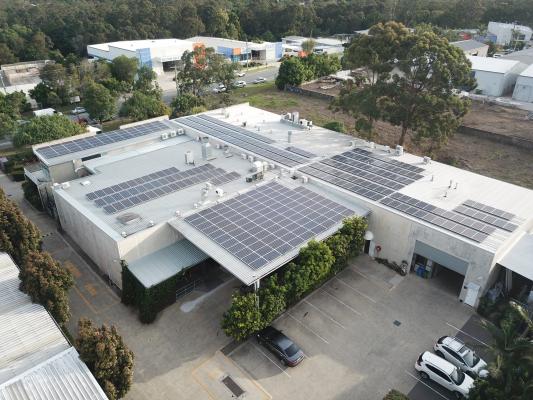By Zero Emissions Noosa
With rising electricity prices in recent years, Belmondo’s Organic Market is surprised not to see more solar systems on surrounding roofs in the industrial precinct. “We are strong advocates for solar. Wewere driven to power our facility with clean, renewable energy in keeping with the overall philosophy of the market,” says Jaxon Taylor of Belmondo’s. Located in Rene Street, Noosaville, Belmondo’s Organic Market is an award-winning marketplace specialising in organic foods and healthy living. Belmondo’s is a commercial landlord with a multi-tenanted space, which is home to a number of businesses involved with organic food production including a butcher, bakery, coffee roaster, cafe and commercial kitchen.
“Before making the decision to install one of the largest solar systems in Noosa, and the largest in Noosaville’s industrial precinct (in 2016), we conducted almost 12 months of research,” says Jaxon. “We easily consume 100 percent of the solar energy generated. However, while we would’ve loved to have installed a larger system, government incentive size limits at the time made a larger system financially unviable for our business.”
“To ensure maximum energy efficiency of the 100kW solar system, we also carried out an LED lighting replacement and installed power factor correction technology. Power factor refers to efficiency of electricity use within the site. At Belmondo’s, a Sinexel Static VAR PFC unit was installed and works on a constant correction to reduce energy costs.”
Key Facts
BUSINESS TYPE LOCATION
Retail and Food Production 59 Rene Street, Noosaville
DATE INSTALLED SIZE
December 2016 100 kW
TECHNICAL
QCells Q Pro 4 265W solar panels; 4 x Fronius Eco 25KW inverters; Sinexel Static VAR Power Factor Correction
COST SAVINGS
The electricity cost savings covers the capital finance repayments. The estimated payback of the system was estimated to be 7 years. The performance of the system has been slightly better than expected, reducing our payback period.EMISSIONS REDUCTION
Greenhouse Gas Emissions Reduction per year: 121 tonnes of CO2-e
Demand Charges – How High?
Many businesses are unaware they pay demand charges are included on in their energy bills. Do you know if your businesses is subject to demand charges? Are you paying too much? A demand tariff is based on your business’s power demand on the network (measured over 30-minute intervals) and the total amount of power used. On your monthly bill, you will see a demand charge based on your electricity demand from the network in kilowatt (kW) or kilovolt-amperes (kVA).
Demand charges are like a car trip – one charge is for the total distance travelled (your total electricity usage), and another charge for the fastest speed on your trip (your peak demand).
Power is measured as the average demand over 30 minutes. The units of power, kVA, are measured by adding up the energy consumed, dividing by the interval of time and including the power factor of the connection. Where the power factor is not available, your demand measure in kilowatts (kW). Peak demand is the highest average 30-minute period of demand over a month. Peak demand can be a large part of your total power bill, depending on the overall rate structure of power access from your retailer.
If your business or factory uses 100kWh of electricity for 15 mins when you turn on all electrical equipment or machinery is starting up, and for the rest of the 30 minute period, it uses 50kWh, then your power use is 150kWh over 30 minute period. Therefore, the demand for this period is 150kWh x 2 = 300kW.
The demand for some tariffs is calculated using ‘any-time’ demand – maximum demand is the highest 30-minute demand period, in a month. Other demand tariffs depend on when the maximum demand occurs.Find out more about demand charges and how to reduce them. Bring your energy bill and come to the ZEN Inc. Business Forum. Book at ZEN Inc. www.zeroemissionsnoosa.com.au/







